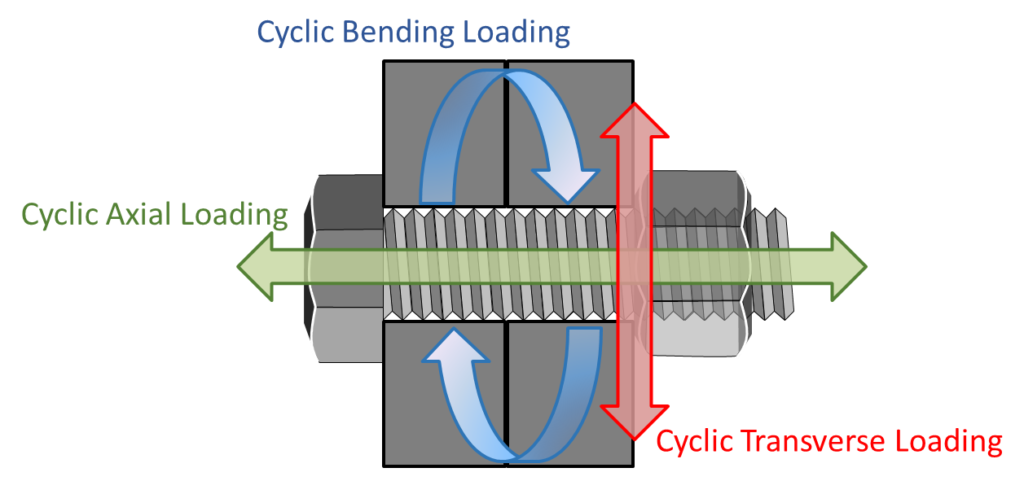Effective Loosening Prevention Strategies
There are a variety of self-locking products available to prevent loose nuts and bolts. There are hundreds of options globally, but self-locking abilities differ greatly.
- Rotational Loosening Prevention Types
- Decelerated Rotational Loosening Types
- Fall-off Prevention Types
- Compensation for Relaxation, Embedment
As we can see, Loosening prevention takes a variety of forms, with varying strengths in self-locking ability.
Consequently, to successfully lock your components, you should be careful to choose the product with the purpose in mind.
Loosening prevention can be broken up into two categories. Rotational Loosening where the nut or bolt will loosen while rotating. Then, Non-rotational loosening where the nut or bolt will not rotate, but the joint will become slack (loss in preload).
When Non-Rotational Loosening is the main factor?
Non-rotational Loosening can be prevented at the joint design stage. The direction and magnitude of External Forces such as prying action, moment resistance etc will be considered. Resultingly, an appropriate fastener should be chosen to prevent any abnormalities in the joint. Torque should be set appropriately, considering variations in the preload due to the friction coefficient and variations in tightening torque due to tool inaccuracy etc.
When the joint can not be redesigned, non-rotational loosening prevention devices such as Disc spring washers can be used to compensate for loss of preload in the assembly. Re-torqueing the joint one more time after installation (1 day to 1 week after) is another useful method to get rid off initial preload loss.
When Rotational Loosening is the main factor?
If you are experiencing Rotational loosening it is very likely that there are transverse loads in play. These repeated transverse loadings cause the nut to slip slightly on the bearing face, resulting in a loss of preload. The reason axial loading is so rare, is because when joint design is undergone correctly axial loading is taken into account and will not create high enough loads to cause loosening of the joint.
The most common strategy to prevent loosening is to increase preload, to increase friction on the bearing surface. However the bolt has limited tensile strength, Sometimes the friction on the bearing surface and nut threads are not enough to prevent nut slipping/ rotation. This can be simply because the bolt can`t be tightened any more because it would break (limited tensile strength). So what can we do? Well, we can stop trying to increase friction on the bearing surface which is the surface that is moving around and is hard to grip. Then we can start increasing friction on the threads of the bolt and the nut. We recommend using Jamming/ Adhesive Methods for the best results. Jamming methods require the use of two nuts; adhesive methods require applying thread-locking fluids to to fill the threads and lock them in place.
Although unfortunate, many experimental studies and literature show that all other locking devices are either in-effective or have limited use.
It is also written that installation must be undergone correctly for Jam nuts and Thread-locking fluids to work effectively. But nevertheless, it is not a simple task to train and instruct engineers to undergo consistent and correct installations out in the field. Since effective locking can not be achieved during installation, the current situation is that most engineers will check bolts and nuts every couple of months? or yearly for loose joints.
To get rid of re-torqueing once and for all, effective installation should be easy, and achievable consistently. HARDLOCK Nut improves on the Double nutting or Jam Nut method allowing for effective locking every time. The conventional jam nut method locked the threads in the axial direction, interfering with the preload of the joint.
Learn more about the true locking “state” of the Jam nut (Double nutting).
Click here.
However the HARDLOCK Nut locks in the transverse direction. This means the functions of the two nuts will not interfere with each other. The inner nut works to deliver preload in the axial direction. The outer nut pulls the inner nut into the threads transversely, only increasing friction on the threads themselves.
Learn more about HARDLOCK Nut.
Our Mission, Pursuing a safer society.
HARDLOCK Nut has been used for over 45 years by clients for many safety-critical applications. Such as Infrastructural applications; Railway, Transmission and Communication Towers, Highways, Bridges. For Power facilities; Nuclear power, Hydro power and Wind power. Also for industries requiring continuous operation such as Machine tooling for Factory/ Plant Equipment, Industrial Machinery. Also, specialized vehicles, research facilities, satellites.
We believe that with the every changing world, and with Recent trends such as DX (Digital Transformation) and Automation, more and more clients will realize the how vital and essential HARDLOCK Nut is, not just for lowering costs, but for ensuring and sustaining safety.
Overall Locking Effectiveness
| Non-positive Locking Devices ( Spring washers etc..) |
Not very effective |
|---|---|
| Positive Locking Devices ( Cotter pins etc..) |
Effective for Fall-off prevention |
| Friction Locking Devices ( Nyloc Nuts etc..) |
Not very effective for preload loss Effective for fall-off prevention |
| Jamming / Adhesive Methods (Double Nutting, Thread-locking fluids, HARDLOCK Nut) |
Very Effective |

Problem

Cyclic Transverse and Bending Loads are the underlying cause of Loose joints
Preventative Measures
| Clean the threads on-site, apply and wait 24 hours for curing. (Difficult) | |
| 2. Double nutting (use of the Jam nut) | The only effective installation technique is the “Nelson Hold”. (Difficult) |
| 3. HARDLOCK Nut | Easy to install with consistent locking results. (Easy) |
 Chinese
Chinese Korean
Korean Japanese
Japanese